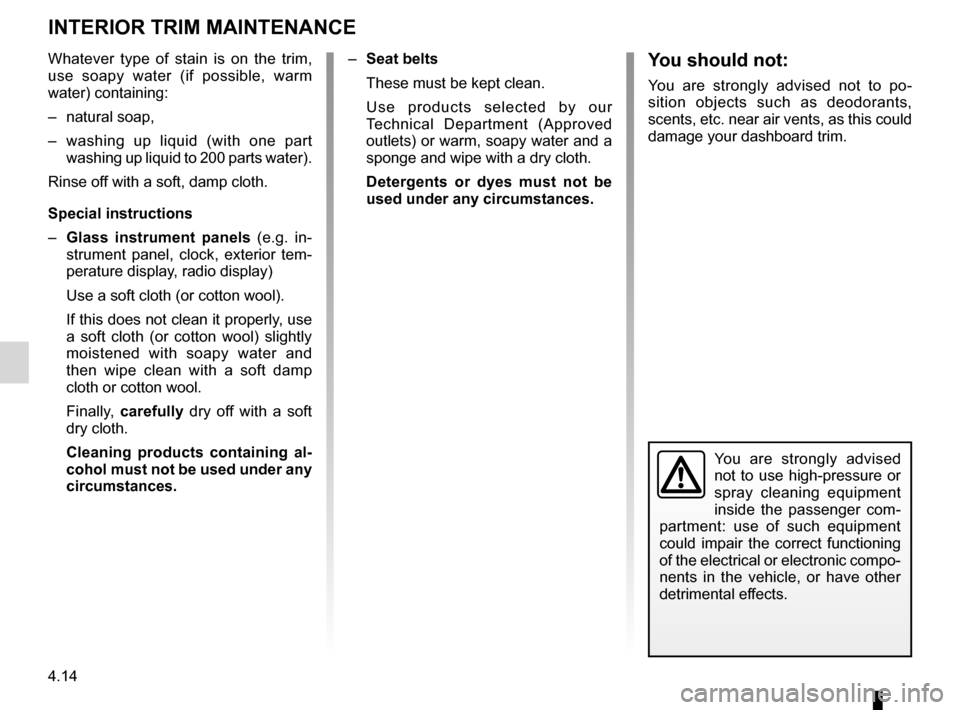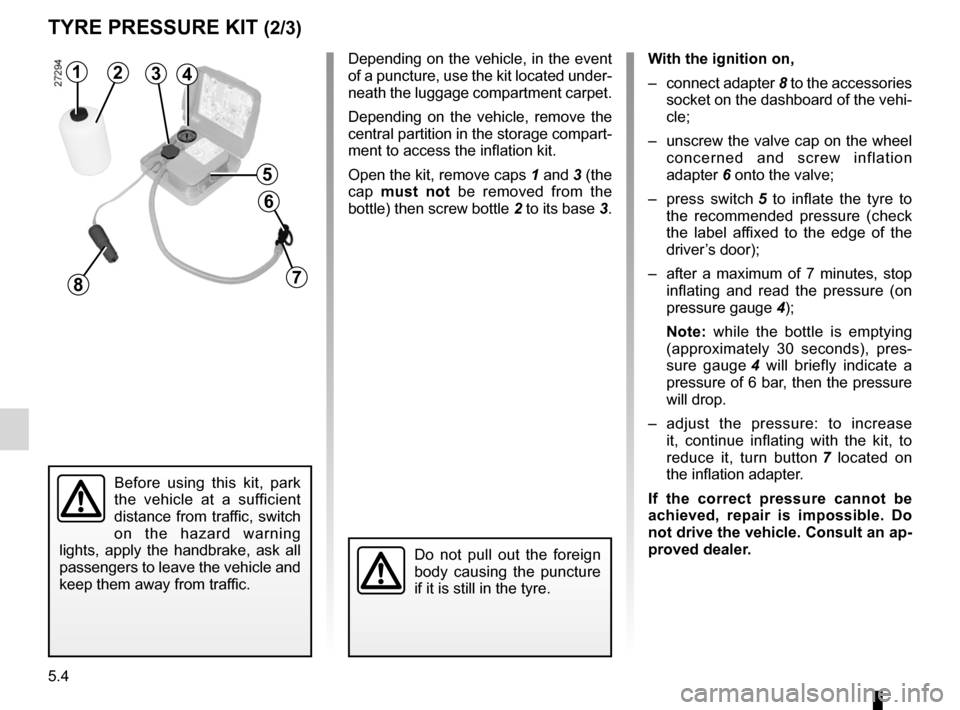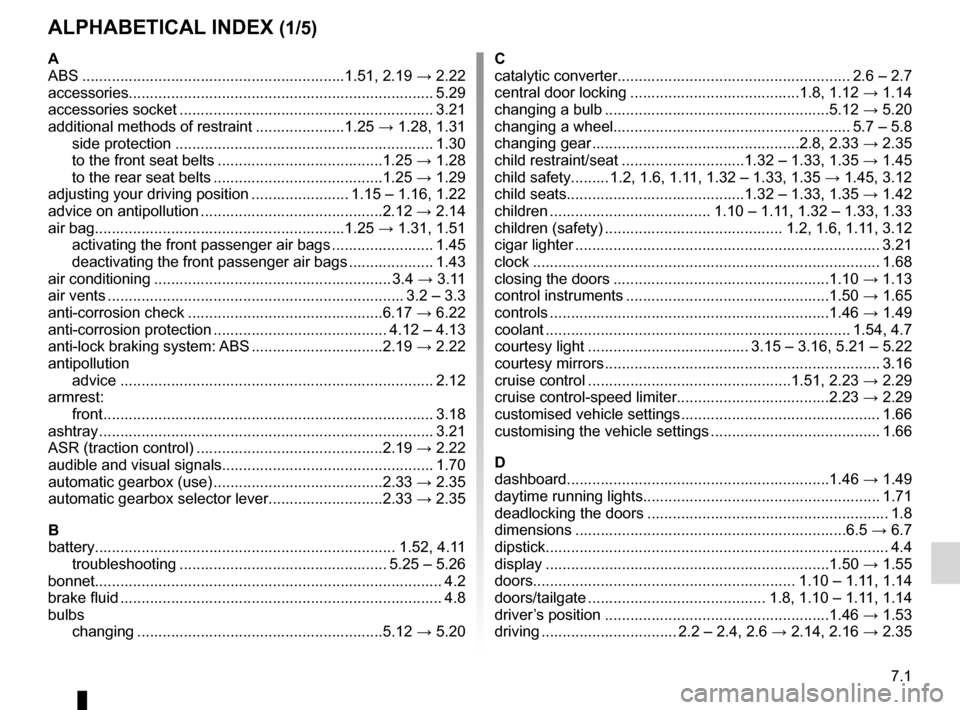dashboard RENAULT MEGANE RS 2012 X95 / 3.G User Guide
[x] Cancel search | Manufacturer: RENAULT, Model Year: 2012, Model line: MEGANE RS, Model: RENAULT MEGANE RS 2012 X95 / 3.GPages: 239, PDF Size: 9.2 MB
Page 172 of 239

maintenance:interior trim ...................................... (up to the end of the DU)
interior trim maintenance ................................... (up to the end of the DU)
4.14
ENG_UD14353_2
Entretien des garnitures intérieures (X95 - B95 - D95 - J95 - R95 - \
L38 - E33 - X33 - X38 - X62 - X32 - B32 - Renault)
ENG_NU_837-6_BDK95_Renault_4
Interior trim maintenance
– Seat belts
These must be kept clean.
Use products selected by our
Technical Department (Approved
outlets) or warm, soapy water and a
sponge and wipe with a dry cloth.
Detergents or dyes must not be
used under any circumstances.
Whatever type of stain is on the trim,
use soapy water (if possible, warm
water) containing:
–
natural soap,
– washing up liquid (with one part
washing up liquid to 200 parts water).
Rinse off with a soft, damp cloth.
Special instructions
– glass instrument panels (e.g. in-
strument panel, clock, exterior tem -
perature display, radio display)
Use a soft cloth (or cotton wool).
If this does not clean it properly, use
a soft cloth (or cotton wool) slightly
moistened with soapy water and
then wipe clean with a soft damp
cloth or cotton wool.
Finally, carefully dry off with a soft
dry cloth.
Cleaning products containing al -
cohol must not be used under any
circumstances.
inteRiOR tRiM MAintenAnCe
y ou should not:
You are strongly advised not to po -
sition objects such as deodorants,
scents, etc. near air vents, as this could
damage your dashboard trim.
You are strongly advised
not to use high-pressure or
spray cleaning equipment
inside the passenger com -
partment: use of such equipment
could impair the correct functioning
of the electrical or electronic compo-
nents in the vehicle, or have other
detrimental effects.
Page 176 of 239

5.4
ENG_UD18914_3
Kit de gonflage (X61 - X95 - B95 - D95 - L38 - X38 - X32 - B32 - Renaul\
t)
ENG_NU_837-6_BDK95_Renault_5
Jaune NoirNoir texte
Depending on the vehicle, in the event
of a puncture, use the kit located under -
neath the luggage compartment carpet.
Depending on the vehicle, remove the
central partition in the storage compart-
ment to access the inflation kit.
Open the kit, remove caps 1 and 3 (the
cap must not be removed from the
bottle) then screw bottle 2 to its base 3.
tyre Pressure KIt (2/3)
Do not pull out the foreign
body causing the puncture
if it is still in the tyre.
143
5
6
78
2
Before using this kit, park
the vehicle at a sufficient
distance from traffic, switch
on the hazard warning
lights, apply the handbrake, ask all
passengers to leave the vehicle and
keep them away from traffic.
w ith the ignition on,
– connect adapter 8 to the accessories
socket on the dashboard of the vehi-
cle;
– unscrew the valve cap on the wheel
concerned and screw inflation
adapter 6 onto the valve;
– press switch 5 to inflate the tyre to
the recommended pressure (check
the label affixed to the edge of the
driver’s door);
– after a maximum of 7 minutes, stop
inflating and read the pressure (on
pressure gauge 4);
n ote: while the bottle is emptying
(approximately 30 seconds), pres -
sure gauge 4 will briefly indicate a
pressure of 6 bar, then the pressure
will drop.
– adjust the pressure: to increase
it, continue inflating with the kit, to
reduce it, turn button 7 located on
the inflation adapter.
If the correct pressure cannot be
achieved, repair is impossible. Do
not drive the vehicle. consult an ap-
proved dealer.
Page 177 of 239

JauneNoirNoir texte
5.5
ENG_UD18914_3
Kit de gonflage (X61 - X95 - B95 - D95 - L38 - X38 - X32 - B32 - Renaul\
t)
ENG_NU_837-6_BDK95_Renault_5
tyre Pressure KIt (3/3)
– affix driving recommendation label 9
to the dashboard where it can easily
be seen by the driver;
– store the kit;
– start the engine straight away and,
after driving a maximum of approx -
imately 2 miles (3 kilometres) or
10 minutes , stop and check the
pressure using the inflation kit. If it is
above 1.3 bar, adjust it to the rec -
ommended pressure (refer to the
label affixed to the edge of the driv-
er’s door), otherwise contact an ap-
proved dealer: repair is not possible.
n ote: after using the inflation kit, you
should visit an approved Dealer to re -
place the inflation hose and the bottle
of repair product.Precautions when using the
kit
The kit should not be operated for more
than 15 consecutive minutes.
Following repair with the kit,
do not travel further than
120 miles (200 km). In addi -
tion, reduce your speed and
under no circumstances exceed 48
mph (80 km/h). The sticker, which
you must affix in a prominent posi -
tion on the dashboard, reminds you
of this.
Depending on the country or local
legislation, a tyre repaired with the
tyre pressure kit will need to be re-
placed.
Nothing should be placed
around the driver ’s feet
as such objects may slide
under the pedals during
sudden braking manoeuvres and
obstruct their use.
9
8
Once the tyre is inflated correctly:
– stop using the kit;
– close the integrated cap on the bottle
again;
– disconnect adapter 8;
Please be aware that a poorly tightened or missing valve cap can make
the tyres less airtight and lead to pressure loss.
Always use valve caps identical to those fitted originally and tighten them
fully.
Page 233 of 239

7.1
FRA_UD19033_8
Index (X95 - B95 - D95 - Renault)
ENG_NU_837-6_BDK95_Renault_7
AlphAbeticAl index (1/5)
A
ABS .............................................................. 1.51, 2.19 → 2.22
accessories........................................................................\
5.29
accessories socket ............................................................ 3.21
additional methods of restraint .....................1.25 → 1.28, 1.31
side protection ............................................................. 1.30
to the front seat belts ....................................... 1.25 → 1.28
to the rear seat belts ........................................ 1.25 → 1.29
adjusting your driving position ....................... 1.15 – 1.16, 1.22
advice on antipollution ........................................... 2.12 → 2.14
air bag ........................................................... 1.25 → 1.31, 1.51
activating the front passenger air bags ........................ 1.45
deactivating the front passenger air bags .................... 1.43
air conditioning ........................................................ 3.4 → 3.11
air vents ...................................................................... 3.2 – 3.3
anti-corrosion check .............................................. 6.17 → 6.22
anti-corrosion protection ......................................... 4.12 – 4.13
anti-lock braking system: ABS ...............................2.19 → 2.22
antipollution advice .......................................................................... 2.12
armrest: front .............................................................................. 3.18
ashtray ........................................................................\
....... 3.21
ASR (traction control) ............................................ 2.19 → 2.22
audible and visual signals .................................................. 1.70
automatic gearbox (use) ........................................ 2.33 → 2.35
automatic gearbox selector lever ...........................2.33 → 2.35
b
battery ....................................................................... 1.52, 4.11
troubleshooting ................................................. 5.25 – 5.26
bonnet ........................................................................\
.......... 4.2
brake fluid ........................................................................\
.... 4.8
bulbs changing .......................................................... 5.12 → 5.20c
catalytic converter
....................................................... 2.6 – 2.7
central door locking ........................................ 1.8, 1.12 → 1.14
changing a bulb ..................................................... 5.12 → 5.20
changing a wheel ........................................................ 5.7 – 5.8
changing gear ................................................. 2.8, 2.33 → 2.35
child restraint/seat ............................. 1.32 – 1.33, 1.35 → 1.45
child safety .........1.2, 1.6, 1.11, 1.32 – 1.33, 1.35 → 1.45, 3.12
child seats .......................................... 1.32 – 1.33, 1.35 → 1.42
children ...................................... 1.10 – 1.11, 1.32 – 1.33, 1.33
children (safety) .......................................... 1.2, 1.6, 1.11, 3.12
cigar lighter ........................................................................\
3.21
clock ........................................................................\
.......... 1.68
closing the doors ................................................... 1.10 → 1.13
control instruments ................................................ 1.50 → 1.65
controls .................................................................. 1.46 → 1.49
coolant ........................................................................\
1.54, 4.7
courtesy light ...................................... 3.15 – 3.16, 5.21 – 5.22
courtesy mirrors ................................................................. 3.16
cruise control ................................................ 1.51, 2.23 → 2.29
cruise control-speed limiter.................................... 2.23 → 2.29
customised vehicle settings ............................................... 1.66
customising the vehicle settings ........................................ 1.66
d
dashboard .............................................................. 1.46 → 1.49
daytime running lights ........................................................ 1.71
deadlocking the doors ......................................................... 1.8
dimensions ................................................................ 6.5 → 6.7
dipstick........................................................................\
......... 4.4
display ................................................................... 1.50 → 1.55
doors .............................................................. 1.10 – 1.11, 1.14
doors/tailgate .......................................... 1.8, 1.10 – 1.11, 1.14
driver’s position ..................................................... 1.46 → 1.53
driving ................................ 2.2 – 2.4, 2.6 → 2.14, 2.16 → 2.35